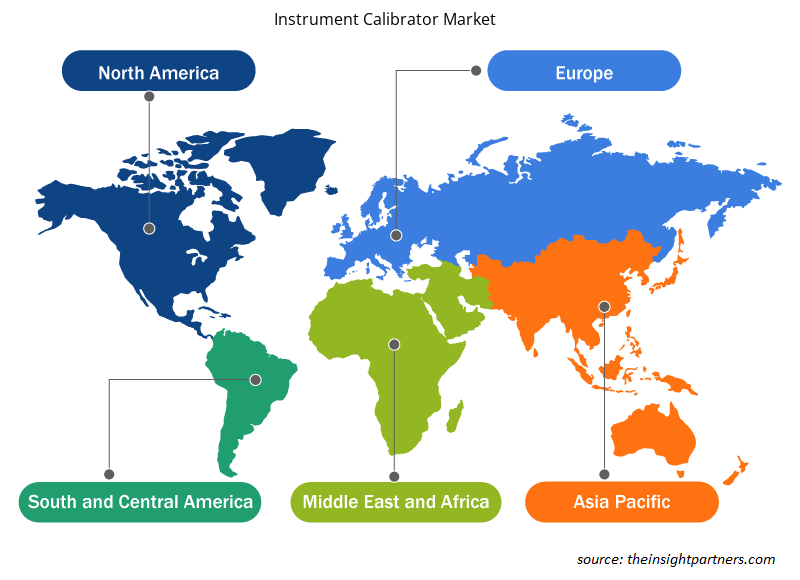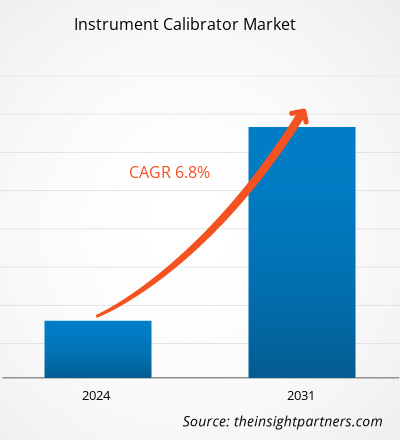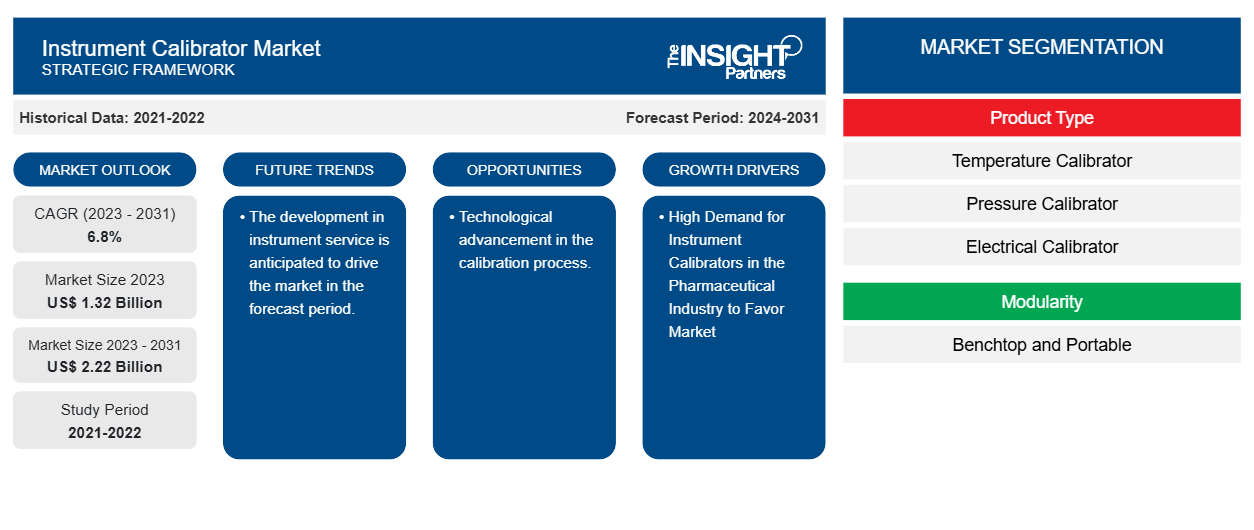Si prevede che la dimensione del mercato dei calibratori di strumenti raggiungerà i 2,22 miliardi di dollari entro il 2031, rispetto agli 1,32 miliardi di dollari del 2023. Si prevede che il mercato registrerà un CAGR del 6,8% nel periodo 2023-2031. La crescente domanda da parte dell'industria farmaceutica, il progresso tecnologico e l'accessibilità economica dei calibratori rimarranno probabilmente tendenze e fattori trainanti chiave nel mercato.
Analisi di mercato dei calibratori di strumenti
Si prevede che la domanda per il mercato dei calibratori di strumenti crescerà con la crescente domanda da parte dell'industria farmaceutica, aerospaziale e della difesa che sta alimentando il mercato dei calibratori di strumenti. Inoltre, si prevede che varie normative governative, progressi tecnologici e calibrazione degli strumenti guideranno il mercato nei prossimi anni.
Panoramica del mercato dei calibratori di strumenti
La calibrazione dello strumento è una parte importante di qualsiasi sistema di misurazione, assicura che gli strumenti funzionino correttamente e forniscano letture precise. È il processo di confronto tra le letture su uno strumento e quelle fornite da uno strumento di riferimento o calibratore. La calibrazione aiuta a garantire affidabilità, accuratezza, sicurezza e conformità con gli standard del settore.
Personalizza questo report in base alle tue esigenze
Riceverai la personalizzazione gratuita di qualsiasi report, comprese parti di questo report, o analisi a livello nazionale, pacchetto dati Excel, oltre a usufruire di grandi offerte e sconti per start-up e università
-
Scopri le principali tendenze di mercato in questo rapporto.Questo campione GRATUITO includerà analisi di dati che spaziano dalle tendenze di mercato alle stime e alle previsioni.
Driver e opportunità del mercato dei calibratori di strumenti.
Elevata domanda di calibratori di strumenti nel settore farmaceutico per favorire il mercato
La calibrazione degli strumenti è un'attività GMP critica nel settore farmaceutico. Garantisce misurazioni accurate degli strumenti critici e aiuta a mantenere la qualità e la sicurezza del prodotto. Questo processo comporta il confronto degli strumenti con standard noti per verificare l'accuratezza entro le tolleranze specificate. Gli impianti farmaceutici sono in grado di funzionare senza calibrazione. Tuttavia, rispettare le severe normative EMEA/FDA e gli standard ISO, per non parlare dell'enorme quantità di strumenti che richiedono una calibrazione regolare, può essere un processo costoso e dispendioso in termini di tempo. Vengono prodotte e archiviate grandi quantità di dati di calibrazione, che devono essere facilmente accessibili, in particolare in caso di audit. Ciò crea un'enorme domanda di calibrazione degli strumenti, che alimenta ulteriormente la crescita del mercato.
Progresso tecnologico nel processo di calibrazione.
I progressi tecnologici nel processo di calibrazione offrono immense opportunità. Poiché la domanda di software automatizzato per una migliore accuratezza ed efficienza dei processi, il software di automazione della calibrazione può essere utilizzato per convertire processi e procedure manuali in attività a basso contatto o addirittura senza contatto. Inoltre, l'intelligenza artificiale per l'apprendimento profondo e la calibrazione intelligente sta guadagnando terreno. Nuove applicazioni di questi strumenti vengono identificate quotidianamente e la calibrazione è uno dei tanti settori che beneficiano di questo boom tecnologico. Pertanto, grazie ai parametri di cui sopra, si prevede che il progresso tecnologico nel processo di calibrazione alimenterà la crescita del mercato nei prossimi anni.benefitting from this technology boom. Thus, owing to the above parameters, technological advancement in the calibration process is anticipated to fuel the market growth in coming years.
Analisi della segmentazione del rapporto di mercato del calibratore di strumenti
I segmenti chiave che hanno contribuito alla derivazione dell'analisi di mercato dei calibratori di strumenti sono il tipo di prodotto, la modularità e il settore verticale.
- In base al tipo di prodotto, il mercato dei calibratori di strumenti è suddiviso in calibratori di temperatura , calibratori di pressione, calibratori elettrici e calibratori di processo multifunzione. Si prevede che il segmento dei calibratori di temperatura deterrà una quota significativa nel periodo di previsione.
- Sulla base della modularità, il mercato dei calibratori di strumenti è da banco e portatile. Si prevede che il segmento portatile deterrà una quota significativa nel periodo di previsione.
- Per settore verticale, il mercato è segmentato in automotive, aerospaziale e difesa, elettronica, alimentare e delle bevande, farmaceutica, petrolio e gas e altri settori. Si prevede che il segmento automotive detenga una quota di mercato significativa nel periodo di previsione.
Analisi della quota di mercato dei calibratori di strumenti per area geografica
L'ambito geografico del rapporto sul mercato dei calibratori di strumenti è suddiviso principalmente in cinque regioni: Nord America, Asia Pacifico, Europa, Medio Oriente e Africa, e Sud e Centro America.
Il Nord America ha dominato il mercato. Il Nord America comprende paesi come gli Stati Uniti, il Canada e il Messico. La regione sta vivendo una crescita sostanziale grazie a fattori come la disponibilità di calibratori di strumenti portatili e da tavolo nelle economie sviluppate e in via di sviluppo. Inoltre, l'elevato utilizzo di calibratori portatili grazie alla loro interfaccia intuitiva e ai prezzi accessibili sta aumentando la loro domanda a livello globale. Inoltre, l'attenzione alla ricerca e allo sviluppo sta aumentando il progresso tecnologico nella regione. Inoltre, la regione ha un gran numero di produttori chiave nel mercato. Pertanto, grazie a tutti questi parametri, il mercato sta guadagnando terreno in Nord America.
Approfondimenti regionali sul mercato dei calibratori di strumenti
Le tendenze regionali e i fattori che influenzano il mercato dei calibratori di strumenti durante il periodo di previsione sono stati ampiamente spiegati dagli analisti di Insight Partners. Questa sezione discute anche i segmenti e la geografia del mercato dei calibratori di strumenti in Nord America, Europa, Asia Pacifico, Medio Oriente e Africa e America meridionale e centrale.

- Ottieni i dati specifici regionali per il mercato dei calibratori di strumenti
Ambito del rapporto di mercato del calibratore di strumenti
| Attributo del report | Dettagli |
|---|---|
| Dimensioni del mercato nel 2023 | 1,32 miliardi di dollari USA |
| Dimensioni del mercato entro il 2031 | 2,22 miliardi di dollari USA |
| CAGR globale (2023-2031) | 6,8% |
| Dati storici | 2021-2022 |
| Periodo di previsione | 2024-2031 |
| Segmenti coperti |
Per tipo di prodotto
|
| Regioni e Paesi coperti |
America del Nord
|
| Leader di mercato e profili aziendali chiave |
|
Densità degli attori del mercato: comprendere il suo impatto sulle dinamiche aziendali
Il mercato dei calibratori di strumenti sta crescendo rapidamente, spinto dalla crescente domanda degli utenti finali dovuta a fattori quali l'evoluzione delle preferenze dei consumatori, i progressi tecnologici e una maggiore consapevolezza dei vantaggi del prodotto. Con l'aumento della domanda, le aziende stanno ampliando le loro offerte, innovando per soddisfare le esigenze dei consumatori e capitalizzando sulle tendenze emergenti, il che alimenta ulteriormente la crescita del mercato.
La densità degli operatori di mercato si riferisce alla distribuzione di aziende o società che operano in un particolare mercato o settore. Indica quanti concorrenti (operatori di mercato) sono presenti in un dato spazio di mercato in relazione alle sue dimensioni o al valore di mercato totale.
Le principali aziende che operano nel mercato dei calibratori di strumenti sono:
- AMETEK Inc.
- Azienda Baker Hughes
- Strumenti Extech
- Società Fluke
- Società elettrica Yokogawa
- WIKAAlexander Wiegand SE & co. KG
Disclaimer : le aziende elencate sopra non sono classificate secondo un ordine particolare.

- Ottieni una panoramica dei principali attori del mercato dei calibratori di strumenti
Notizie e sviluppi recenti sul mercato dei calibratori di strumenti
Il mercato dei calibratori di strumenti viene valutato raccogliendo dati qualitativi e quantitativi dopo la ricerca primaria e secondaria, che include importanti pubblicazioni aziendali, dati di associazioni e database. Di seguito sono elencati alcuni degli sviluppi nel mercato dei calibratori di strumenti:
- ABB ha avviato la costruzione di una nuova sala di taratura di 12.000 piedi quadrati nel parco industriale adiacente al suo attuale stabilimento di produzione di 200.000 piedi quadrati a Bartlesville, Oklahoma. L'investimento rafforzerà le capacità di taratura dell'azienda e fornirà ai clienti elevati livelli di qualità e accuratezza nell'intera gamma di misuratori di portata ABB. Aumenterà inoltre ulteriormente l'offerta "Made in America" dell'azienda. (Fonte: sito Web aziendale ABB, gennaio 2024)
- Dracal Technologies ha annunciato la firma di un accordo tra Dracal Technologies ed Essco Calibration Laboratory negli Stati Uniti. Essco è un laboratorio accreditato ISO/IEC 17025:2017 con oltre 50 anni di esperienza nella calibrazione di strumenti di misura. (Fonte: Dracal Technologies, sito Web aziendale, novembre 2023)
Copertura e risultati del rapporto sul mercato dei calibratori di strumenti
Il rapporto "Dimensioni e previsioni del mercato dei calibratori di strumenti (2021-2031)" fornisce un'analisi dettagliata del mercato che copre le seguenti aree:
- Dimensioni e previsioni del mercato dei calibratori di strumenti a livello globale, regionale e nazionale per tutti i principali segmenti di mercato interessati dall'ambito di applicazione.
- Tendenze del mercato dei calibratori di strumenti e dinamiche di mercato quali fattori trainanti, limitazioni e opportunità chiave.
- Analisi dettagliata delle cinque forze PEST/Porter e SWOT.
- Analisi di mercato dei calibratori di strumenti che copre le principali tendenze di mercato, il quadro globale e regionale, i principali attori, le normative e i recenti sviluppi del mercato.
- Analisi del panorama industriale e della concorrenza che comprende la concentrazione del mercato, l'analisi delle mappe di calore, i principali attori e gli sviluppi recenti per il mercato dei calibratori di strumenti.
- Profili aziendali dettagliati.
- Analisi storica (2 anni), anno base, previsione (7 anni) con CAGR
- Analisi PEST e SWOT
- Valore/volume delle dimensioni del mercato - Globale, Regionale, Nazionale
- Industria e panorama competitivo
- Set di dati Excel
Report recenti
Testimonianze
Motivo dell'acquisto
- Processo decisionale informato
- Comprensione delle dinamiche di mercato
- Analisi competitiva
- Analisi dei clienti
- Previsioni di mercato
- Mitigazione del rischio
- Pianificazione strategica
- Giustificazione degli investimenti
- Identificazione dei mercati emergenti
- Miglioramento delle strategie di marketing
- Aumento dell'efficienza operativa
- Allineamento alle tendenze normative























 Ottieni un campione gratuito per - Mercato dei calibratori di strumenti
Ottieni un campione gratuito per - Mercato dei calibratori di strumenti